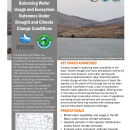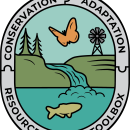Location
States
Arkansas, Louisiana, New Mexico, Oklahoma, TexasEcosystem
River/streamIntroduction
The Red River Basin is a transboundary river basin spanning the states of New Mexico, Texas, Oklahoma, Arkansas, and Louisiana. Thirty-eight major reservoirs in the basin supply water for nearby metropolitan areas (such as Oklahoma City and Dallas-Fort Worth), crop irrigation, and industrial use.
Western areas of this drought-prone basin are more arid while areas further east receive more than 50 inches of rain per year. Climate change affects both of these areas by increasing temperatures, evaporation rates, and the frequency of both drought and extreme precipitation events. While valuable for supplying water for human use, reservoirs can limit instream flows through the basin’s riparian riparian
Definition of riparian habitat or riparian areas.
Learn more about riparian ecosystems, which are home to over 150 native fish species (Gill et al., 2020). Increasing water demands and climate change climate change
Climate change includes both global warming driven by human-induced emissions of greenhouse gases and the resulting large-scale shifts in weather patterns. Though there have been previous periods of climatic change, since the mid-20th century humans have had an unprecedented impact on Earth's climate system and caused change on a global scale.
Learn more about climate change make it more difficult to balance human and environmental water needs. Therefore, there is increasing attention on the need for flow regimes that support native species. Environmental flows are the appropriate quantity, quality, and timing of freshwater flows needed to sustain riparian ecosystems, which are valuable for supporting human cultures and economies (Arthington et al. 2018).
In support of environmental flows, water managers can implement strategic reservoir releases or incentive-based water conservation programs that compensate water users for decreasing their water usage. To identify areas where the investment of conservation resources will be maximized in support of environmental flows, researchers from the Department of Geography and Environmental Sustainability at the University of Oklahoma modeled optimal freshwater usage and future species distributions under future climate scenarios.
Key Issues Addressed
Climate change is impacting water availability in the Red River Basin. While there is uncertainty among climate models, a majority project slightly less precipitation in the western portion of the basin and slightly more precipitation in the eastern portion of the basin (Sabzi et al., 2019). Precipitation extremes, both severe drought and heavy precipitation events, will become more frequent and problematic. Warmer temperatures will increase evapotranspiration rates, further stressing water resources.
Fish species in the Red River Basin hold considerable ecological and recreational value. However, these species are stressed by declining water availability, habitat fragmentation, water quality issues, and the effects of climate change. Scientists predict climate change will alter the distributions of basin fish species, but the extent of this change has not yet been quantified.
Efforts to implement conservation actions that support environmental flows face significant socio-political obstacles, such as insufficient funds, a lack of coordination among water agencies, and managers' differing views on the value of environmental flows. A lack of regulations permitting environmental flows and concerns that environmental flows may interfere with existing water use permits present additional challenges. Furthermore, uncertainty among climate projections can make managers hesitant to prioritize and implement conservation actions. Without an understanding of stakeholders’ communication patterns and views on environmental flows, it is difficult to coordinate water conservation efforts.
Project Goals
- Model water availability and usage in the Red River Basin under several climate scenarios to account for uncertainties regarding future carbon emission trends
- Quantify variation in fish species’ distributions across future climate scenarios
- Evaluate water managers' attitudes towards environmental flows and analyze their communication patterns to understand existing challenges and support the most effective and collaborative water management strategies
- Utilize an optimization model and future species distribution information to identify areas where the investment of conservation resources would be most beneficial
Project Highlights
Beyond the Basin: This approach to modeling future water availability and demand in the Red River Basin can be applied to drought-prone river basins in other parts of the world.
- Decision-Support Tools: Researchers constructed a spatial planning model to optimize the supply of water for both human and environmental needs. To model how water availability and demand will change due to climate change, the team used the Variable Infiltration Capacity (VIC) hydrologic model and U.S. Geological Survey estimates of water use to project water availability and demand under a variety of future climate scenarios across all counties in the Red River Basin. To understand how an incentive-based water conservation system might perform in the basin, the team also used the model to investigate tradeoffs between social equity, economic efficiency, and conservation outcomes of such systems.
- Prioritizing Areas for Aquatic Species Conservation: The researchers compiled historical occurrence records for 31 basin fish species considered to be representative of current management priorities and projected their future distributions under different climate scenarios using the MaxEnt species distribution model. The model used variables including temperature, precipitation, elevation, soil type, and anthropogenic barrier density to predict future distributions for each species. Next, researchers overlaid the predicted species distributions for the year 2050 to display hotspots of species loss. This analysis can help practitioners identify areas to prioritize future climate mitigation and conservation efforts that may have the most favorable outcomes for native species.
- Connecting with Stakeholders: The research team used the South Central Climate Adaptation Science Center’s Usable Water Resources Community of Practice as a meeting venue to explain the concept of environmental flows and where water conservation actions might be implemented. The meetings were valuable for addressing the needs and concerns of community of practice members such as the Chickasaw and Choctaw Nations, whose lands are mostly contained within the basin. The team surveyed water and natural resource managers in the basin to understand their varied perspectives on environmental flow. From the analysis, researchers created a connectivity map to understand communication between stakeholders, as well as highlight barriers and opportunities for collaboration.
- Framework for Prioritizing Water Conservation: By considering the spatial patterns of water scarcity across the basin under nine climate projections for 2031–2050, researchers designated the 38 major reservoirs as either “Rarely Water Scarce,” “Sometimes Water Scarce,” or “Often Water Scarce.” Each designation has a corresponding recommendation for the level of investment in water conservation that considers water scarcity and climate model uncertainty.
Lessons Learned
The spatial planning model demonstrated that small, collective reductions in human water use have the potential to generate large environmental benefits. By comparing estimates of future water demand with the outputs of the VIC hydrologic model, researchers generally expect water demand to increase while streamflow decreases in the basin. Even so, there is great spatial variability in projected changes in water availability and demand. The researchers also demonstrated that an equitable approach to allocating water conservation incentives across water use sectors (municipal, industrial, and agricultural) is more cost-effective than compensating a single water use sector.
The research team found that future distributions of individual species are highly uncertain across climate scenarios, but they were able to highlight areas where 31 fish species are projected to be most negatively impacted. They recommend strategic reservoir releases to mitigate species loss due to unfavorable stream temperature and flow under future climate conditions. However, climate change may stress certain areas of the basin to the point where conservation efforts are no longer practical. Practitioners can use this information to determine locations where conservation efforts may have the most favorable outcomes for native fish species.
The Red River Basin is a complex socioeconomic system, so it was important for the researchers to capture the views of many groups, including federal and state agencies, Tribal Nations, and private entities. Water resources transcend man-made boundaries, so collaboration among water managers across political jurisdictions and economic sectors is essential for balancing water needs in drought-prone basins.
Considering a variety of climate scenarios allowed the researchers to provide three investment strategies to water managers. For regions with reservoirs designated “Often Water Scarce,” water managers can comfortably invest in infrastructure projects to increase water availability, such as the construction of reservoirs or pipelines. Regions with reservoirs projected to be “Sometimes Water Scarce” (those located in areas of high climate uncertainty) are best for flexible conservation investments and additional research. In these areas, incentives for decreased water use are an appropriate strategy because funds for incentives are easier to reallocate than infrastructure projects. Assuming there is no dramatic increase to water demand, regions with “Rarely Water Scarce” reservoirs should have enough water such that they simply require monitoring.
Next Steps
- Integrate biophysical and social models to determine when and where in the basin to implement incentive-based water conservation
- Conduct research with conservation actors and water users to model decisions on collaboration and willingness to participate in incentives-based water conservation
- Explore methods of implementing an incentive-based water conservation program in the Red River Basin
Funding Partners
South Central Climate Adaptation Science Center
Resources
- MaxEnt Species Distribution Model
- Variable Infiltration Capacity (VIC) hydrologic model
- Summaries of Decision Support Data for Identifying the Most Cost-Effective Water Conservation Projects in the Red River basin
- South Central Climate Adaptation Science Center’s Usable Water Resources Community of Practice
- University of Oklahoma Department of Geography and Environmental Sustainability
- Arthington et al. (2018). “The Brisbane Declaration and Global Agenda on Environmental Flows (2018).” Frontiers in Environmental Science 4: 45.
- Presentation: Climate Change and Water Resources: Potential climate impacts on water resources and ecosystems in the Red River
- Gill et al. (2020). “Hotspots of species loss do not vary across future climate scenarios in a drought-prone river basin.” Ecology and Evolution 10: 9200- 9213.
- Fovargue et al. (2021). “Spatial planning for water sustainability projects under climate uncertainty: balancing human and environmental water needs.” Environmental Research Letters 16: 034050.
- Wineland et al. (2021). “Is there enough water? How bearish and bullish outlooks are linked to decision maker perspectives on environmental flows.” Journal of Environmental Management 280: 111694.
- Wineland et al. (2023). “Small tradeoffs between social equity and conservation outcomes in a freshwater payment for ecosystem services scheme.” Ecological Applications 33: e2829.
- Wineland et al. (2021). “The environmental flows implementation challenge: Insights and recommendations across water-limited systems.” WIREs Water 9: e1565.
- Zamani Sabzi et al. (2019). “Strategic allocation of water conservation incentives to balance environmental flows and societal outcomes.” Ecological Engineering 127: 160-169.
- Zamani Sabzi et al. (2019). “Comparison of projected water availability and demand reveals future hotspots of water stress in the Red River basin, USA.” Journal of Hydrology 26: 100638.
Contacts
- Thomas Neeson, Department of Geography and Environmental Sustainability, University of Oklahoma: neeson@ou.edu
- Madeline Wade, Department of Geography and Environmental Sustainability, University of Oklahoma: madeline.wade@ou.edu
- Sean Emmons, USGS: semmons@usgs.gov
CART Lead Authors
- Jack Carter, CART Student Writer, University of Oklahoma
- Haylee Kraker, CART Student Writer, University of Oklahoma
Suggested Citation
Carter, J., B., Kraker, H.,J., and Jewell, K., D. (2024). “Balancing Water Usage and Ecosystem Outcomes Under Drought and Climate Change Conditions.” CART. Retrieved from https://www.fws.gov/project/balancing-water-usage-and-ecosystem-outcomes.




